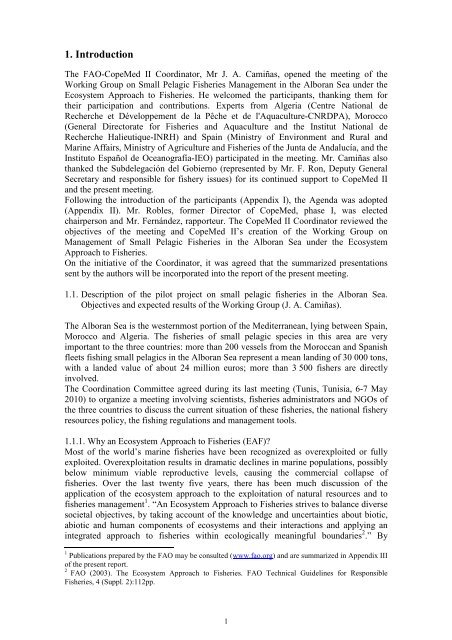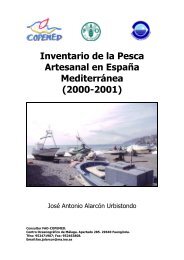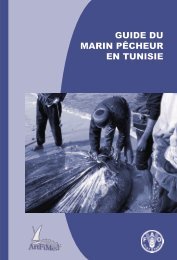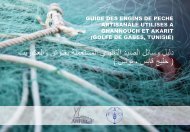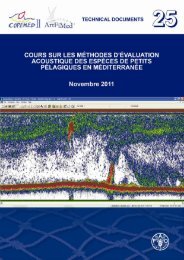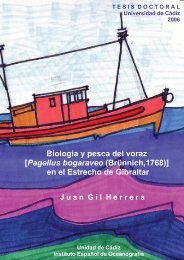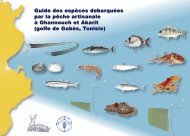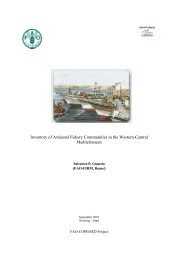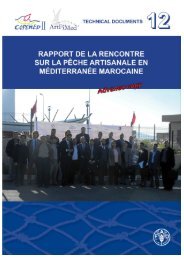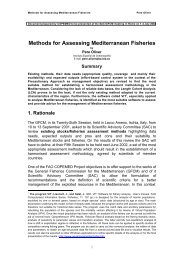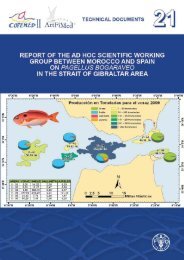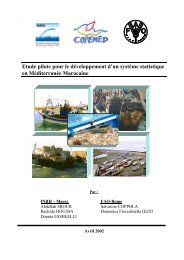CopeMed II - ArtFiMed TD Nº18 - Report of the ... - Fao - Copemed
CopeMed II - ArtFiMed TD Nº18 - Report of the ... - Fao - Copemed
CopeMed II - ArtFiMed TD Nº18 - Report of the ... - Fao - Copemed
- No tags were found...
You also want an ePaper? Increase the reach of your titles
YUMPU automatically turns print PDFs into web optimized ePapers that Google loves.
1. IntroductionThe FAO-<strong>CopeMed</strong> <strong>II</strong> Coordinator, Mr J. A. Camiñas, opened <strong>the</strong> meeting <strong>of</strong> <strong>the</strong>Working Group on Small Pelagic Fisheries Management in <strong>the</strong> Alboran Sea under <strong>the</strong>Ecosystem Approach to Fisheries. He welcomed <strong>the</strong> participants, thanking <strong>the</strong>m for<strong>the</strong>ir participation and contributions. Experts from Algeria (Centre National deRecherche et Développement de la Pêche et de l'Aquaculture-CNRDPA), Morocco(General Directorate for Fisheries and Aquaculture and <strong>the</strong> Institut National deRecherche Halieutique-INRH) and Spain (Ministry <strong>of</strong> Environment and Rural andMarine Affairs, Ministry <strong>of</strong> Agriculture and Fisheries <strong>of</strong> <strong>the</strong> Junta de Andalucía, and <strong>the</strong>Instituto Español de Oceanografía-IEO) participated in <strong>the</strong> meeting. Mr. Camiñas alsothanked <strong>the</strong> Subdelegación del Gobierno (represented by Mr. F. Ron, Deputy GeneralSecretary and responsible for fishery issues) for its continued support to <strong>CopeMed</strong> <strong>II</strong>and <strong>the</strong> present meeting.Following <strong>the</strong> introduction <strong>of</strong> <strong>the</strong> participants (Appendix I), <strong>the</strong> Agenda was adopted(Appendix <strong>II</strong>). Mr. Robles, former Director <strong>of</strong> <strong>CopeMed</strong>, phase I, was electedchairperson and Mr. Fernández, rapporteur. The <strong>CopeMed</strong> <strong>II</strong> Coordinator reviewed <strong>the</strong>objectives <strong>of</strong> <strong>the</strong> meeting and <strong>CopeMed</strong> <strong>II</strong>’s creation <strong>of</strong> <strong>the</strong> Working Group onManagement <strong>of</strong> Small Pelagic Fisheries in <strong>the</strong> Alboran Sea under <strong>the</strong> EcosystemApproach to Fisheries.On <strong>the</strong> initiative <strong>of</strong> <strong>the</strong> Coordinator, it was agreed that <strong>the</strong> summarized presentationssent by <strong>the</strong> authors will be incorporated into <strong>the</strong> report <strong>of</strong> <strong>the</strong> present meeting.1.1. Description <strong>of</strong> <strong>the</strong> pilot project on small pelagic fisheries in <strong>the</strong> Alboran Sea.Objectives and expected results <strong>of</strong> <strong>the</strong> Working Group (J. A. Camiñas).The Alboran Sea is <strong>the</strong> westernmost portion <strong>of</strong> <strong>the</strong> Mediterranean, lying between Spain,Morocco and Algeria. The fisheries <strong>of</strong> small pelagic species in this area are veryimportant to <strong>the</strong> three countries: more than 200 vessels from <strong>the</strong> Moroccan and Spanishfleets fishing small pelagics in <strong>the</strong> Alboran Sea represent a mean landing <strong>of</strong> 30 000 tons,with a landed value <strong>of</strong> about 24 million euros; more than 3 500 fishers are directlyinvolved.The Coordination Committee agreed during its last meeting (Tunis, Tunisia, 6-7 May2010) to organize a meeting involving scientists, fisheries administrators and NGOs <strong>of</strong><strong>the</strong> three countries to discuss <strong>the</strong> current situation <strong>of</strong> <strong>the</strong>se fisheries, <strong>the</strong> national fisheryresources policy, <strong>the</strong> fishing regulations and management tools.1.1.1. Why an Ecosystem Approach to Fisheries (EAF)?Most <strong>of</strong> <strong>the</strong> world’s marine fisheries have been recognized as overexploited or fullyexploited. Overexploitation results in dramatic declines in marine populations, possiblybelow minimum viable reproductive levels, causing <strong>the</strong> commercial collapse <strong>of</strong>fisheries. Over <strong>the</strong> last twenty five years, <strong>the</strong>re has been much discussion <strong>of</strong> <strong>the</strong>application <strong>of</strong> <strong>the</strong> ecosystem approach to <strong>the</strong> exploitation <strong>of</strong> natural resources and t<strong>of</strong>isheries management 1 . “An Ecosystem Approach to Fisheries strives to balance diversesocietal objectives, by taking account <strong>of</strong> <strong>the</strong> knowledge and uncertainties about biotic,abiotic and human components <strong>of</strong> ecosystems and <strong>the</strong>ir interactions and applying anintegrated approach to fisheries within ecologically meaningful boundaries 2 .” By1 Publications prepared by <strong>the</strong> FAO may be consulted (www.fao.org) and are summarized in Appendix <strong>II</strong>I<strong>of</strong> <strong>the</strong> present report.2FAO (2003). The Ecosystem Approach to Fisheries. FAO Technical Guidelines for ResponsibleFisheries, 4 (Suppl. 2):112pp.1


